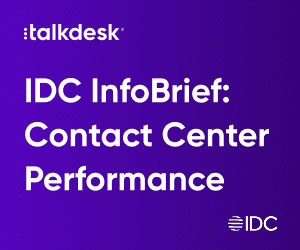Our panel of experts discuss their favourite methods for improving contact centre demand planning.
1. Behaviour Profiles
Holiday periods, marketing promotions and product launches are all examples of events that impact contact volumes. Building behaviour profiles for each will improve future planning.
To do so, analyse volatility within historic contact volumes when these events previously occurred and the length of the disruption.
Each time the event recurs, tweak the relevant profile and increase future forecast accuracy.
Yet not all events are a certainty, which increases the difficulty of forecasting. The weather is a classic example that affects contact volumes across several sectors.
To stay prepared, create multiple forecasts. Each forecast should represent a different scenario that changes how and why customers get in touch. Doing so reduces uncertainty.
On this topic, test different forecast models when building behaviour profiles. While one model may generally work best, another may be better at predicting contact volumes on special occasions – such as holiday periods.
2. Holt-Winters
Since the 1960s, contact centres have used the Holt-Winters technique – also known as triple exponential smoothing, to forecast.
Still, to this day, it remains a contact centre stalwart and is used within many modern workforce management (WFM) systems.
This technique hinges upon three elements:
- Level – the forecast from the previous month
- Trend – the expected increase or decrease in contacts from the previous month
- Seasonality – the impact of the seasons on data
To forecast, the idea is to isolate each element and average the data – or “smooth” it – exponentially from one period to the next.
Yet, like every forecasting model, this method has its drawbacks.
For starters, it’s better suited to long-term forecasts, and overfitting the data is a common struggle. Because of this, contact centres experiment with multiple models and home-grown algorithms to discover which best suits their environment.
WFM tools speed up this process. They contain hundreds of algorithms that contact centres can test using historical data much more quickly.
3. Shift Bidding
Available within most WFM tools, shift bidding allows advisors to self-serve their shifts through an app or website. Advisors can also choose their breaks and lunches.
Such a flexible strategy enables planners to schedule more accurately and meet forecasted demand.
Why? Because they’re not bound by agent preferences. Instead, advisors can view upcoming unassigned shifts and bid for them, pinpointing their first and second choices – saving time and increasing employee engagement.
The fly in the ointment is that not everyone wants to bid for shifts. Some would prefer a set schedule. If this is the case, schedule these advisors first. Then kickstart a bidding process for the remaining shifts.
Another common concern is what happens when multiple people bid for the same shift? Many will enable the most qualified advisor to claim it. Others will offer it to the highest performer. Either way, contact centres can set rules according to which method works best for them.
Finally, before implementing self-service WFM, educate the frontline team on classic planning principles and theory. Advisors are then more likely to use the tool in line with best practice.
4. Your Ears

Charlie Sneddon
In many cases, a planner’s most valuable tool is their ears. By simply listening to what advisors are saying, behaviours come to light. These may explain significant planning trends.
Yet advisors often feel detached from the WFM team and may even view planners as the “computer says no” villains. Such perceptions foster negativity, but the planning team have the power to change them.
Run planning forums to uncover advisor frustrations, with common gripes including:
- A lack of notice before schedules are published
- Perceived unfairness within shift patterns
- Little opportunity for emergency shift-swaps
Also, use these sessions to engage the team, discovering what they want within their schedules and what will provide them with a better work/life balance.
Listen to this feedback, highlight key points and use this to guide improved schedules that please advisors and better meet demand. Keep communication open to showcase improvement.
If it’s not possible to make the changes that advisors request, explain why. Show them demand profiles and bring planning challenges to life. The team will then become more reasonable if they are disappointed in the future.
Thanks to Charlie Sneddon at Calabrio
5. Forecasting Average Handling Time (AHT)
Alongside contact volumes, AHT is another critical metric to be considered when forecasting.
Assess historical handling times to discover the impact caused by recurring events. Future handling time assumptions may then need to change.
Considerations for forecasting AHT include:
- New agents
- Changes to processes/scripts
- Changes to products
- Changes to systems
- Variations in AHT in different sites on the same campaign
- Exceptional events
- Operational performance improvement
The underlying importance of this point is that every percent variation in AHT has a similar impact on the resources required, with cost and performance implications.
6. Shift Reviews
Managing change to shift patterns, especially in large operations, is tricky, and planners can expect resistance – especially if there is limited consultation with the team.
For this reason, some companies delay this task, with many not undertaking a shift review at all. Doing so leaves them with legacy shift patterns that fail to align with operational efficiency.
So run shift reviews while also drawing up options for potential shift patterns and surveying advisors to assess their preferences. Modern contact centres may then improve demand planning and engagement.
7. Intraday Levers

Jim Fleming
Having intraday levers, written down as operational checklists, standardizes the ability of the contact centre to react to forecast deviations.
If there is significant pressure due to call volumes and/or staffing issues, a simple intraday checklist may allow the contact centre to follow an agreed operational process.
For example, if call volumes are significantly higher than forecast, cancel all coaching and training sessions that day to ensure all hands on deck. Another option is to pull in skilled individuals from back-office teams for emergency support.
Alternatively, if the contact centre is overstaffed, it may then attempt to plug performance gaps through impromptu training sessions or provide short-notice leave.
Defining these levers allows the call centre to be more proactive than reactive in its approach to intraday management.
Thanks to Jim Fleming at Sabio
8. Contingency Planning
Understanding the impact of fluctuations in contact volumes helps highlight vital scenarios that require planning.
Sudden increases in contact volumes by 100, 200 or even 500% may have dire consequences for a company.
In some industries, for example, there may be strict regulatory requirements. These establish that a failure to respond within specific timescales could result in fines.
For others, the concern is a loss of sales or people repeatedly calling with unanswered queries, therefore perpetuating the cycle.
In both cases, frustration and poor customer experience will likely result in negative publicity.
Once the impact of altered demand is understood, consider the most effective ways to mitigate it. A combination of “all hands on deck” alongside digital deflection and automation tools often presents the most comprehensive and efficient approach.
9. Digital Deflection
Having contingency plans to provide an updated IVR menu and extra self-service options for specific events helps manage demand.
Such a tactic eases the frustration triggered by a generic: “We are experiencing a high call volume…” announcements. These leave customers feeling helpless when many would be perfectly capable of solving their own issues – if given the option.
Consider targeted and specific messages such as “We are experiencing high call volume. Press 1 to be sent a link to our virtual assistant or press 2 to schedule a callback.”
Such a message provides customers with options and immediate access to self-service tools. Rather than simply telling them to go to the website, they benefit from the convenience of links and prompts provided to them.
Potentially, with a flexible system, contact centres can build in more specificity. For example: “We are aware that X banking services are disabled at present and expect this to be resolved within 24h. Press 1 to receive a link so you can arrange a callback after that time if you are still experiencing issues. Press 2…”. Such a message may buy precious time to plan.
10. Speech and Data Analytics

Maxine Allard
These tools allow brands to closely inspect interactions and potentially provide an early warning for fluctuations in customer demand.
Based on voice and text conversations, these systems proactively identify trends, themes and root causes.
Social media conversations are a great example, as many customers now turn to these channels to express dissatisfaction and concerns.
Intelligent use of data from the CRM system and software solutions such as CCaaS enable contact centres to quickly spot problem areas and initiate procedures to resolve or handle them.
Experienced advisors and supervisors can also contribute knowledge that will enrich the databases. For instance, an increase in calls with certain reason codes may have previously taught them that more serious problems lie ahead.
Thanks to Maxine Allard at Odigo
11. Human Adjustment

Drew Naylor
While workforce management (WFM) tools are will maximize demand planning strategies, try to get people involved too.
Human input is crucial. People provide a valuable layer in demand planning, as team members have extensive experience and can ensure that automated forecasts align with their past experiences.
Planners may also provide context and rationale to some of the planning software outputs.
The ability to make such adjustments is crucial, as demand planning tools cannot be completely efficient and accurate when used as the single source of the truth without validation.
Thanks to Drew Naylor at MaxContact
12. Multiple Advanced Algorithms (Including ARIMA)

Brian Mistretta
Testing more than one forecasting method improves forecast accuracy.
Multiple advanced algorithms, such as Box-Jenkins, ARIMA (Auto-Regressive Integrated Moving Average) and Exponential Smoothing, enable planners to switch between many forecasting methods.
Such a capability is levels above assuming that one method will work all the time. Every algorithm has benefits that fit different scenarios.
Additionally, software that leverages a “pick the best scenario” function can automatically generate, compare and select the best AI-forecasting model with the highest accuracy for various events.
Thanks to Brian Mistretta at NICE CXone
13. Balanced Thinking

Dave Vernon
Avoid spending hours and hours of analytical effort forecasting customer demand, only to neglect paying equal attention to the other assumptions that go into any good plan. These include handling time, shrinkage, schedule fit and recruitment assumptions.
Failing to give the same level of diligence to these items and viewing the customer demand forecast in blissful isolation won’t deliver the level of performance that the business requires.
However, if the contact centre can do so, they will ensure clarity regarding the supply of agents and what they can deliver. This may then be compared to projected demand, highlighting variations.
Also, try to understand the flexibility tolerance of staff on the day to understand how far this resource can flex upwards and downwards. Doing so can negate the need to forecast demand down to the finest details.
Thanks to Dave Vernon at The Forum
14. “What If” Scenario Planning

Neil Draycott
A popular demand planning technique is scenario planning.
Such a technique tests the effect of different actions on specific scenarios. Planners may then make better decisions about where to allocate resources.
Some WFM tools allow the user to run “what if” scenarios to simplify the process.
Using this tool, contact centres can forecast metric values, test new scenarios and re-run calculations.
Examples of where running a ‘what-if’ scenario can come in handy for contact centres include:
- Opening hours – A contact centre may wish to find out the benefits of extending their working hours. Running “what if” scenario planning can help the contact centre determine whether they can cope in this scenario. It will also identify the impact on the business and reallocate resources to improve demand planning.
- New product launch – A contact centre may want to discover current resource implications if they launch a brand-new product.
Thanks to Neil Draycott at Business Systems
15. Real-Time Adherence

Brian Spraetz
Real-time adherence and trending insights allow supervisors to manage adherence proactively, ensuring that WFM plans stay on the right track.
Being able to track adherence in real time is, however, just one benefit of a WFM tool.
Four other great examples are:
- Forecasting models create a baseline and are compared to actual results to detect and act on any variances
- Self-service features empower advisors to participate in the WFM process
- What-if capabilities support detailed staff planning for seasonality or growth
- Complex operations with multiple skills, sites and contact channels may align their strategy
Thanks to Brian Spraetz at Five9
16. Extra Staffing

Frank Sherlock
Consider the long-term benefits of having a few extra staff on hand to answer calls, on top of the estimated forecast.
For starters, this creates a safety net that protects the contact centre from inevitable inconsistencies or issues such as staff absence.
Yes, it’s a short-term cost, but it can deliver long-term ROI, reduced wait times for your customers and better service.
It’s also worth considering the benefits for existing staff. Lower strain and work overload through additional customer service reps will not go unnoticed.
Sometimes, after all, best practice is to live by the mantra: “It’s better to be safe than sorry.” Short-term costs can lead to long-term value for your organization.
Thanks to Frank Sherlock at CallMiner
17. Homeworking Solutions

Steve Mosser
Specialist work-from-home (WFH) scheduling solutions address this issue by enabling homeworkers to build their schedules around their personal constraints.
For businesses, this provides a heightened certainty of adherence but also more granularity of resourcing by posting requirements in 30-minute intervals.
Ultimately, this yields better people and business outcomes. As a matter of fact, for one financial services business, the use of a WFH scheduling platform means that it only pays for the hours needed and that home agents supply.
In doing so, contact centres can reduce overstaffing, shrinkage and boost productivity to deliver significant cost savings compared with its in-house operations.
Thanks to Steve Mosser at Sensée
18. Algorithmic Forecasting

Jay Gupta
WFM software uses algorithmic forecasting to generate effective staffing plans and schedules that meet service levels and other metric targets.
Testing many algorithms will enable planners to identify which work best within their unique contact centre environment and those that best forecast special events – i.e. bank holidays.
Other tools and techniques, such as call deflection and triaging, also help manage demand when resources are stretched too thin or when there are low levels of available staff.
Thanks to Jay Gupta at Talkdesk
19. Behaviour Prediction

Rob Smith
Companies attuned to market changes, localized economic events and industry trends may start to predict customer behaviour.
These predictions will inform demand planning, triggering a forecast and staffing response.
Companies that want to stay ahead of market trends will commit to almost continuous reforecasting, which will help to react to changing conditions.
Thanks to Rob Smith at Alvaria
20. AI and Machine Learning

Omri Hayner
Contact centres have complex scheduling needs and a unique set of requirements that require more planning than the average business department.
Infusing AI and machine learning in demand planning helps to schedule the right workforce with the right skill set in the right place at the right time on the right channel.
Automatically matching schedule opportunities with advisor preferences is an excellent example of this.
Thanks to Omri Hayner at NICE
For more demand planning insights from industry specialists, check out the following content:
- 50 Expert Tips to Improve Contact Centre WFM
- WFM Tricks That Will Get You Through Busy Periods
- Shift Planning FAQs Answered by an Expert
Author: Robyn Coppell
Published On: 18th Oct 2021 - Last modified: 10th Jan 2025
Read more about - Call Centre Management, Alvaria, Brian Mistretta, Brian Spraetz, Business Systems, Calabrio, CallMiner, Drew Naylor, Editor's Picks, Five9, Forecasting, Frank Sherlock, Jay Gupta, MaxContact, NICE, NICE CXone, Odigo, Sabio, Scheduling, Sensee, Talkdesk, The Forum








































